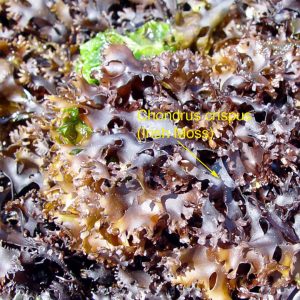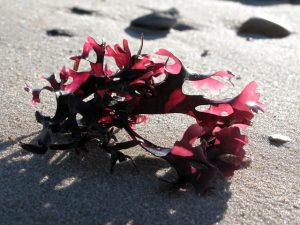Irish Moss
(Chondrus crispus)
- Alias names for Irish Moss: Phyllum Rhodophyta. Gigartinaceae, Carragheen, Caragahen, Stackhouse, Carragaheen, Chondrus
- Chinese Names for Irish Moss: None found
Pictures of Irish Moss:
References for Irish Moss pictures:
- https://www.biopix.com/Photo.asp?PhotoId=8810&Photo=Chondrus-crispus
- https://www.sciencemag.org/cgi/content/full/317/5846/1858
About Irish Moss: Carrageen / Irish Moss is one of the most widely used seaweeds throughout the world. Reddish brown and growing up to 10 inches (25cm) it inhabits the Atlantic coasts of Europe and North America (particularly in the English Channel and on the Massachusetts coast). It grows just below the waterline attached to rocks and stones in shallow pools of salt water and is harvested in the fall with rakes or by hand. The harvesters are careful to leave some of the plant attached to the rocks so that it will grow back for future harvests. It is one of the seaweeds that you will have eaten – probably without knowing it! In the food industry world it’s E numbers are E400 to E420 and E406, E407 and E407a. These food additive numbers are important because some people are actually allergic to this sea vegetable.
Actions and Uses of Irish Moss:
- Acid indigestion
- Cancer and chronic disease (helps rebalance cell salts of the cells)
- Chapped skin
- Coughs and bronchitis (acts as an expectorant)
- Cystitis
- Demulcents
- Dermatitis
- Emollients
- Gastritis
- Hand lotions
- Heartburn
- Nourishing food for invalids
- Reduces gastric secretions
- Slightly blood thinning
- Soothes dry and irritated mucous membranes
- Thickening agent for the food industry
- Tuberculosis cough
- Urinary infections
How Irish Moss is used and How it Works: It is a stabilizer used in —
- Air fresheners
- Brewing industry
- Food industry (stabilizer of dairy products, desserts, salad dressings, sauces, and cod liver oil)
- Leather industry
- Paint industry
- Pharmaceutical industry
- Textile industry
- Toothpaste
Parts of Irish Moss Plant Used: The whole plant
Properties of Irish Moss: The polysaccharides become jellylike and thicken when exposed to water.
Chemical Constituents of Irish Moss: Polysaccharides, proteins (up to 10%), amino acids, iodine, bromine, iron, sulphur, potassium, magnesium, sodium, pectin.
Contraindications, safety issues, concerns, harmful drug interactions and allergy precautions for Irish Moss: Those people on blood thinners and anticoagulants should consult their doctor before taking this herb (which is a sea vegetable) as it does thin the blood a bit. Some people may be allergic. One resource I read said that carragheenans were suspected of being carcinogenic and could possibly cause ulcerative colitis, but Dr. John Christopher (a famous herbalist) uses it in many ways not even discussed here and often for cancer.
Other notes: Irish moss is often mixed with Cinnamomum cassia, glycyrrhiza glabra, Althaea officianlis and Ballota nigra herbs.
These products are not drugs, but foods for special dietary use pursuant to applicable Federal law. No statement in this page shall be construed as offering these products for the diagnosis, cure, mitigation, treatment, or prevention of any disease.
Helpful Links and References for Irish Moss:
- Irish Moss Drink: https://www.jamaican-recipes.com/irishmoss.html
- Nutritive value of Irish moss: https://www.jbc.org/cgi/reprint/233/2/406.pdf

